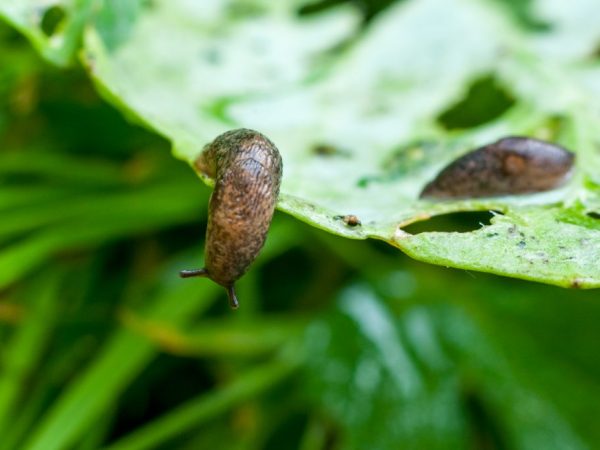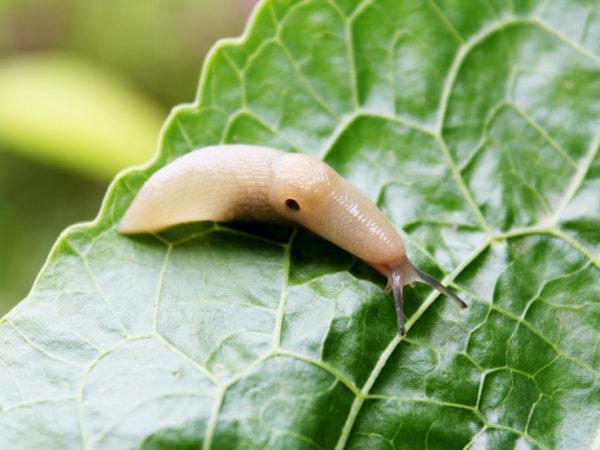Fighting slugs on cabbage
Slugs on cabbage give gardeners a lot of trouble. They appear on vegetables throughout the gardening season, often completely destroying the cabbage crop.

Fighting slugs on cabbage
Description of the pest
Outwardly, slugs are similar to snails and belong to the same family of gastropods, only they lack a shell. Instead of a shell, they are protected by mucus covering the entire body, which leaves a shiny gray trail when the insect moves.
Harm
In the daytime, mollusks hide in damp, dark places, and slugs begin to crawl out onto cabbage at nightfall. At dusk, they gnaw on cabbage leaves and heads of cabbage, remaining in the beds until morning.
Crawling over the plants, slugs carry fungal and viral infections throughout all plantings.
In the rainy cool season, pests appear in the daytime. Among all cabbage varieties, the mollusks inflict the least harm on the red-headed variety.
Preventive measures
Fighting slugs that appear in cabbage is much more difficult than protecting plants in time, preventing the appearance of pests on cabbage plantings.
Site cleaning
Slugs prefer dark and humid places, therefore, timely harvesting of weeds and leaf residues after the previous harvest on the site will not create conditions for rotting and will not lead to the formation of a favorable environment for the pest.
Obstacle creation
You can prevent the appearance of mollusks in the beds by creating obstacles. To do this, fences are made around the garden:
- from dug trenches with water,
- from strips of lime,
- from sawdust,
- from scrap materials with sharp edges, for example, spruce needles, husks of sunflower seeds, shell rock, eggs and nutshells.
Attracting enemies
Natural enemies of slugs are birds and insects, they help get rid of pests that have appeared on cabbage. Molluscs are food for jackdaws, rooks and starlings, they are eaten by poultry: chickens and duck, and ground beetles also feed on invertebrates. In the fight against them, to attract birds in the area where vegetables grow, bait with food is made and flower stalks that attract insects are planted.
Chemicals

Thunderstorm preparation helps to get rid of insects
In the fight against slugs on cabbage plantings, chemical agents are almost never used: mollusks are not very susceptible to their compositions. However, a number of drugs have proven to be effective against slugs on cabbage. For example, a tool called "Thunderstorm", which includes metaldehyde as a component. The drug has a selective effect, since it contains substances that attract mollusks, but scare away insects and birds.
The activity of the chemical drug begins 2 hours after the shellfish enters the body.
An effective chemical agent against slugs is hazard class 3 and consists of small granules. It is scattered around cabbage plantings.Consumption rate - 15 g per 5 sq. m. It can be used in rainy weather, since the active substances of the drug remain effective even under conditions of high humidity.
Traditional methods
In the fight against slugs, folk methods show themselves effectively.
Traps
It is quite difficult to use mechanical methods of collecting mollusks in the beds, because in the daytime they hide in the foliage of plants and in the soil layer. A more effective folk way are traps that summer residents make with and without baits.
- Pieces of plywood or cardboard, roofing material or slate are laid out in the aisles on abundantly moistened soil, which mollusks take for a shelter - they crawl under them when morning comes. By turning over these shelters, it is easy to pick up the pests by hand.
- The slugs are perniciously affected by heat, accompanied by high humidity, which can be created artificially if the soil around the cabbage plantings is covered with cellophane. Slugs crawling in the morning hours will die under a waterproof shelter, which, under the influence of sunlight, will create hot condensation under the film.
- The originated drinks containing yeast (beer or kvass) act as bait for slugs. They are poured into containers buried near the plants growing in the beds at ground level. To prevent beneficial insects from entering them, for example, bees, they are closed during the daytime.
- Mollusks are attracted by the smell of laundry soap, pieces of which are placed in plastic bottles buried near cabbage plantings so that the neck remains at ground level.
Vinegar
Table vinegar with a concentration of 9% helps to protect planting from slugs on cabbage. It is diluted in an amount of 200-400 ml in 10 liters of water. Cabbage plantings are sprayed with this solution in the evening hours.
Mustard
The smell of mustard frightens off molluscs from plants, if it is sprayed with a vegetable crop in the evening. 100 ml of mustard requires 10 liters of water.
Ash and tobacco
Dusting with wood ash or tobacco helps to effectively fight slugs that appear on cabbage. For best efficiency, add 1 tbsp to 1 liter of ash powder. l. salt, mustard and hot pepper. The dusting procedures are repeated a week later, or earlier if it has rained.
Conclusion
It is possible to get rid of slugs on cabbage, but it is better not to allow them to appear. Observe preventive measures, take care of the crop in a timely manner, because the pest most often appears when the crop is grown in unfavorable conditions.


